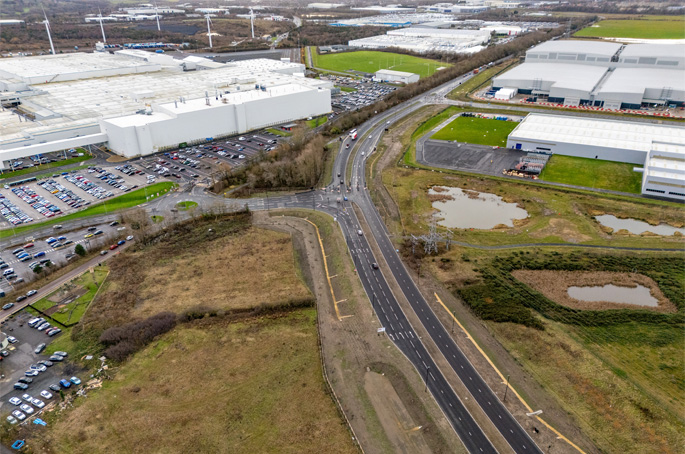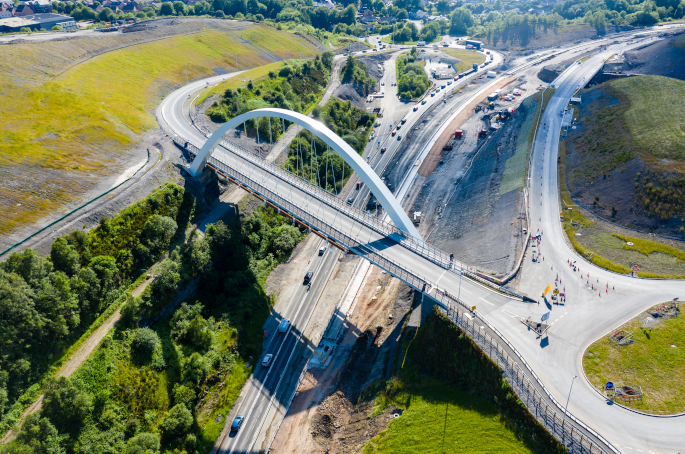The Treasury has released a 10-year infrastructure strategy, backed by at least £725bn of government funding, outlining a shift to more ‘place-based' integrated investment decisions.
The £725bn includes cash already announced at the Spending Review: at least £24bn for roads in the next four years, a £1bn structures fund, £15.6bn through the Transport for City Regions settlements, and a £7.9bn 10-year pipeline of capital investment for flood defences.
Integrated plans
‘This is the first time that the UK has set out a long-term strategy that brings together economic infrastructure with housing and social infrastructure,' Darren Jones, chief secretary to the Treasury said.
He added that given past issues in infrastructure delivery, including delays and cost overruns, the government would set about ‘doing fewer things better instead of the same things badly'.
He concluded that the 10-year strategy 'sits at the heart of our plans to renew the UK'.
Chancellor of the Exchequer, Rachel Reeves added: ‘We're not just fixing buildings – we're enhancing public services, improving lives and creating the conditions for sustainable economic growth in communities throughout the UK.'
The new approach is based on three pillars:
- Reforming institutions and the approach to delivery.
- Providing certainty through government funding and developing a pipeline of infrastructure projects.
- Removing barriers to delivery through an enhanced spatial approach to planning, planning reform, more effective working with the construction sector and wider supply chains and building a skilled workforce.
Helping co-ordinate the agenda will be the National Infrastructure and Service Transformation Authority (NISTA), which was launched in April.
NISTA will lead the development of ‘the Government's national infrastructure spatial digital tool to strengthen the local evidence base for place-based infrastructure investment decisions', the strategy states.
‘By overlaying contextual datasets on land use, environmental considerations and economic potential, this work will provide evidence on where infrastructure can make the biggest contributions to economic growth. For the first time, needs assessments will look across both social and economic infrastructure.'
Appraisals and funding
With ongoing reforms of the Green Book, HM Treasury will also introduce ‘place-based' business cases, to bring together the different projects that are needed to achieve the objectives of a particular place'.
This new approach will help ensure ‘that central government properly considers complementarities between different projects such as housing and transport'.
The Government will also oversee the development of spatial plans for key infrastructure sectors, including transport and roads, and committed to ‘greater integration and coverage of sectoral spatial plans'.
As well as allowing more top-down consideration of place, the government plans new forms of bottom-up control from local government.
The aim is to move away from the current centralised model of investment: ‘Public investment accounted for around 80% of total investment in transport infrastructure in 2023-24, with the remaining 20% a mix of public and private funding. The vast majority of public funding for transport is financed from central government grants.'
In response, NISTA with support from the Department for Transport, will take forward a study by early 2026 ‘to explore the ways in which revenue streams can be diversified… to enable more transport projects to be brought forward in future'.
This will include mechanisms such as land value capture, which played a role in funding Crossrail in London.
Treasury officials placed a strong emphasis on private finance for new projects, highlighting the latest options for funding the Lower Thames Crossing.
The Government revealed that work on a Regulated Asset Base funding model is being done to help finance the Lower Thames Crossing. This is a funding framework employed primarily in regulated infrastructure sectors to determine the allowed revenues which can be earned by assets.
Elsewhere the government fell in line with recommendations from the second National Infrastructure Assessment to prioritise maintenance – stating that it is ‘focusing on maintenance and renewals within the £24bn of capital funding allocated between 2026-27 and 2029-30 for motorways and local roads across the country'.
As well as reiterating funding commitments to the end of this spending review period (2030) and sometimes beyond, the government hopes to engage the private sector through its commitment to upcoming works.
Launching in July, a new interactive portal for the Government's Infrastructure Pipeline will allow businesses to see the types of opportunities available up to 10 years ahead.
There was also a strong commitment to resilience in the strategy, with a 10-year funding package for flood defences and a pledge to publish a National Security Strategy and Resilience Strategy.
Government modelling and projections suggesting: that around a third of all roads (38%) and railways (37%) are in areas at risk from one or more sources of flooding, rising to around half (46% and 54%, respectively) by the middle of the century.
Sector reaction
Angela Jones, president of ADEPT, said: ‘We welcome the government's new approach to funding, which promises long-term certainty of five years. This commitment will enable local authorities to move away from the cycle of emergency repairs and adopt a more strategic, preventative approach to infrastructure management.
'The strategy's recognition of these climate resilience challenges is particularly important as we work to futureproof our networks.' Sue Percy CBE, chief executive of CIHT said the strategy was ‘an important milestone for the highways, transport and infrastructure sector'.
‘CIHT has consistently called for certainty for our sector and we hope that the details outlined in this strategy will go some way to providing the consistency to approach that highways and transportation has needed for many years.' In briefing notes, the CIHT said that many of its recommendations have been considered as part of the strategy including:
‘Prioritisation of funding for maintenance and renewals of the existing transport infrastructure. Specifically addressing the backlog in transport maintenance that is critical to ensure resilience and reliability.
Integrated planning for new infrastructure: The necessity of considering from the outset how other systems, particularly transport, will support and connect to developments. Transport planning should be an integral part of housing strategies. Consideration of the interdependencies between infrastructure systems, such as transport, telecoms, and water management.
Chris Scudamore, capital projects & infrastructure leader at PwC, said the £725bn infrastructure package ‘is nothing short of a generational reset for the UK's ageing infrastructure systems'.
‘If delivered with intent and precision, it could reshape the social and economic fabric of the country. The real test now lies in execution. Government and industry must act as true partners by aligning finance, delivery, and ambition. A spatial approach to planning is a smart move: infrastructure doesn't exist in isolation, and neither should its strategy.
‘Private finance will be essential to bridge the gap. Public funding alone won't get us there. And while commitments to skills, innovation, and productivity are welcome - the pace of AI disruption means we must move faster.'

























